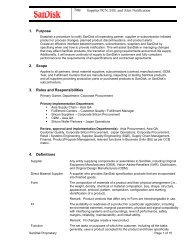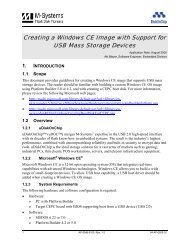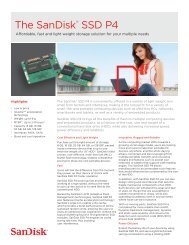Membrain Software White Paper - SanDisk
Membrain Software White Paper - SanDisk
Membrain Software White Paper - SanDisk
Create successful ePaper yourself
Turn your PDF publications into a flip-book with our unique Google optimized e-Paper software.
WHITE PAPER<br />
Delivers breakthrough<br />
10x server consoli dation<br />
<strong>Membrain</strong> <strong>Software</strong><br />
Enterprise cache. Built for flash.<br />
Synopsis<br />
<strong>Membrain</strong> is mission-critical cache. Increase the density of cache to power server consolidation,<br />
reduce power consumption and lower overall total cost of ownership (TCO). Boost response<br />
times for critical applications with in-memory like performance. Learn more in this white paper.
Table of Contents<br />
Introduction ..............................................................................................................................................1<br />
Memcached Overview..........................................................................................................................2<br />
<strong>Membrain</strong> Architecture........................................................................................................................2<br />
Hardware Platform............................................................................................................................2<br />
The <strong>SanDisk</strong> Operating Environment (SOE)...........................................................................2<br />
Memcached Client/Server Protocol...........................................................................................3<br />
<strong>SanDisk</strong> Data Fabric.........................................................................................................................3<br />
Flash Management ...........................................................................................................................3<br />
Flash and Network Management................................................................................................4<br />
Administration.........................................................................................................................................4<br />
Key Capabilities......................................................................................................................................4<br />
Using Flash Memory to Increase Capacity, Reduce Power, and Provide Persistence........4<br />
Using Replication and Automated Failover for HA and Disaster Recovery...............6<br />
Using Backup and Restore to Protect Against Data Corruption or Loss....................7<br />
Using Containers to Manage Consolidation............................................................................8<br />
Using Cloning to Rapidly Deploy and Warm Identical <strong>Membrain</strong> Nodes....................8<br />
Using Administrative Services to Deploy, Management, and Scale...............................9<br />
Network Configuration ...................................................................................................................9<br />
Enhanced Memcached Statistics..............................................................................................10<br />
Putting It All Together: <strong>Membrain</strong> Use Cases...........................................................................10<br />
Reducing TCO through Consolidation....................................................................................10<br />
Industry-Leading Data and Service Availability........................................................................ 11<br />
Summary ................................................................................................................................................. 12<br />
TABLE OF CONTENTS
Introduction<br />
With the explosive growth of high-volume web sites, software-as-a-service (SaaS), cloud<br />
computing, and other emerging web-based applications, datacenter workloads have increased<br />
exponentially. The business opportunities that are created from the deployment of these<br />
new applications are substantial, but the demands they place on the datacenter are daunting.<br />
Challenges include unprecedented data growth, large increases in rack space and power consumption,<br />
too much time-sensitive data to process in a rapid and consistent manner, inability<br />
to effectively scale to meet demand, underutilized resources, and severe space,<br />
power, and budget constraints.<br />
A software cache and / or persistent key-value store is now a key part of the software infrastructure<br />
of many datacenters. Unfortunately, the traditional caching solutions (such as the<br />
widely used Memcached protocol) and key-value store products are loosely coupled and lack<br />
overall optimization. These products do not adequately address the performance, capacity,<br />
scaling, availability, and power challenges of supporting new Web applications effectively.<br />
Huge advances in multi-core processors, flash memory, and high-performance networking<br />
offer huge improvements in performance and power at the component level. But these new<br />
component technologies are severely underutilized when datacenters integrate them at the<br />
data-access tier. Serious scaling, performance, power, networking, space, and complexity<br />
issues still remain.<br />
To address these challenges and opportunities, new system architectures and solutions that<br />
match the workload, operating environments, and hardware are needed. <strong>SanDisk</strong> has taken<br />
a breakthrough, holistic approach to harness these powerful technology advances to create<br />
<strong>Membrain</strong>: a breakthrough software cache and persistent NoSQL key-value store optimized<br />
to take full advantage of flash memory, multi-core processors, and high-performance<br />
interconnects.<br />
<strong>Membrain</strong> is a high-performance, highly available, cost-effective, and scalable solution that<br />
meets today’s demanding data-access needs. Relative to traditional Memcached and the other<br />
NoSQL key-value stores, <strong>Membrain</strong> delivers order-of-magnitude improvements in performance,<br />
scaling, downtime, power, and space, while cutting total cost of ownership (TCO) by more than<br />
half. The net result is more efficient and highly-available datacenter operations and the ability<br />
to create new revenue-producing business opportunities based on rapid access to terabytescale<br />
data.<br />
<strong>Membrain</strong> powers production workloads in leading Web facing, SaaS, cloud, and enterprise<br />
datacenters today. <strong>Membrain</strong> offers, among other things, the following unique features:<br />
Industry-leading throughput, capacity, and data and service availability by tightly integrating<br />
the Memcached protocol with the innovative <strong>SanDisk</strong> Operating Environment (SOE) and<br />
standard server and flash memory, significantly reducing capital expense, power consumption,<br />
rack space, and networking requirements;<br />
Comprehensive data and service availability through a rich set of high-availability/disasterrecovery<br />
(HA/DR) features, including Persistent Caching, Active/Active Replication, RAID,<br />
and Backup & Restore; and<br />
100% memcapable compatibility with all existing Memcached client libraries, applications,<br />
and tools, making it easy to integrate into existing environments.<br />
<strong>SanDisk</strong> customers highly value the consolidation and TCO savings afforded by <strong>Membrain</strong>. For<br />
example, using <strong>Membrain</strong> instead of traditional DRAM-only caching brought a social networking<br />
company a 10:1 reduction in the number of servers and a media company a 12:1 reduction in<br />
the number of servers needed to service the same workload. <strong>Membrain</strong> customers enjoy large<br />
savings in TCO, power, space, and application complexity.<br />
PAGE 1
The industry-leading data and service availability provided by <strong>Membrain</strong> is a key benefit valued<br />
by its users. Some <strong>SanDisk</strong> customers use <strong>Membrain</strong> as their sole data repository, without a<br />
database as the primary data store. For these customers, the comprehensive data and service<br />
availability of <strong>Membrain</strong> is critical. For example, a <strong>SanDisk</strong> telecom customer stores all the<br />
address books for users of mobile and cable services in <strong>Membrain</strong> servers. They configure the<br />
<strong>Membrain</strong> nodes with transparent replication and automatic failover, and they use the <strong>Membrain</strong><br />
Backup/Restore facility for periodic backups for recovery from disasters and less catastrophic<br />
forms of data corruption, such as those caused by client application defects.<br />
The rest of this white paper describes: Memcached; the architecture of <strong>Membrain</strong>; the key capabilities<br />
of <strong>Membrain</strong>; and use cases for <strong>Membrain</strong>. We conclude with a summary of key points.<br />
Memcached Overview<br />
Memcached is a distributed key-value caching is widely used in high-traffic Web sites.<br />
Memcached is generic, providing caching for arbitrary chunks of data such as results from<br />
database calls or page renderings. Memcached is proliferating because of its effectiveness at<br />
off-loading database and application servers, with dramatic improvement in Web site response<br />
time and throughput.<br />
Memcached is based on a standard client/server protocol which is maintained by the<br />
Memcached open-source community, which also maintains various client libraries, a reference<br />
server implementation, and management, administrative and compliance tools.<br />
<strong>Membrain</strong> Architecture<br />
<strong>Membrain</strong> seamlessly integrates the Memcached protocol with the <strong>SanDisk</strong> Operating<br />
Environment (SOE) (described later in this white paper) and the underlying hardware platform<br />
to provide superior enterprise caching and key-value store performance, capabilities, and<br />
features.<br />
<strong>Membrain</strong> is based on a system architecture that holistically manages state-of-the-art, enterprise-class<br />
flash memory, multi-core processors, DRAM, and high-performance networking to<br />
optimize the performance, availability, and TCO of the Memcached client/server protocol. This<br />
architecture was created based on extensive workload characterization, system modeling, and<br />
optimization. The result is a highly optimized cache/key value store that effectively harnesses<br />
these powerful technologies to provide a solution that is scalable, smart, cost-effective, and<br />
green. Web facing datacenters can now leverage the advanced technology of <strong>SanDisk</strong>’s tightly<br />
integrated solution to quickly and easily manage data growth, decrease business complexity,<br />
and cut TCO.<br />
Hardware Platform<br />
<strong>Membrain</strong> runs standard x86 servers with flash memory. The recommended hardware platform is:<br />
Dell, HP, or IBM x86 server or blade with at least 64GB of DRAM<br />
PCI-e enterprise flash memory or at least 5 SATA/SAS SSDs<br />
A single 10Gb or multiple 1-Gb Ethernet ports.<br />
The <strong>SanDisk</strong> Operating Environment (SOE)<br />
The SOE unlocks the full potential of the hardware by optimizing the utilization of all the<br />
available physical resources across a broad spectrum of workloads. It enables full utilization<br />
and linear scalability of multi-core processors, intelligently manages caching from DRAM to<br />
flash, delivers highly parallel read- and write-optimized flash memory access, and manages high<br />
performance replication of cached data between <strong>Membrain</strong> servers.<br />
The SOE consists of the Memcached client/server protocol layer, <strong>SanDisk</strong> data fabric, the flash<br />
management subsystem, flash and network management, and administration, as shown in<br />
Figure 1 on the following page.<br />
PAGE 2
<strong>SanDisk</strong> Operating Environment (SOE)<br />
Memcached client/server protocol<br />
100% compatible<br />
Data Fabric<br />
Thread & Core Management<br />
Synchronization/Concurrency Management<br />
DRAM Cache Management<br />
Container Management<br />
Replication Management<br />
Flash Management Subsystem<br />
Space Allocation<br />
Object Replacement (Cache Mode)<br />
Persistency Management<br />
Flash & Network Management<br />
Highly Concurrent I/O & Messaging<br />
Data Striping, RAID<br />
Administration<br />
Configure • Monitor • Control • Optimize<br />
Figure 1: <strong>SanDisk</strong> Operating Environment (SOE)<br />
Memcached Client/Server Protocol<br />
The SOE protocol layer accepts Memcached commands and is a fully Memcapable 100%-<br />
compatible implementation of the standard Memcached client/server protocol. <strong>Membrain</strong> is<br />
therefore 100% compatible with all client applications. Using the familiar Memcached APIs,<br />
client applications can perform both distributed caching operations and persistent NoSQL<br />
key-value store operations.<br />
<strong>SanDisk</strong> Data Fabric<br />
The <strong>SanDisk</strong> data fabric layer implements the fundamental algorithms necessary to maximize<br />
system balance, performance, power efficiency, and availability. The <strong>SanDisk</strong> data fabric functions<br />
include:<br />
Fine-grained, highly concurrent and efficient multithreading and core management required<br />
to parallelize hundreds of thousands of simultaneous flash and network accesses per second;<br />
Intelligent, dynamic DRAM caching required for fast and efficient staging of both small and<br />
large objects;<br />
Creation and management of dynamic containers providing fine-grained control over cached<br />
data, supporting attributes of size, persistence, store vs. cache mode, and replication;<br />
Transparent, highly optimized data replication and failover.<br />
Flash Management<br />
The flash management layer provides space and persistence management across the parallel<br />
flash devices. The flash management subsystem functions include:<br />
Mapping object keys to flash locations, employing algorithms that minimize the amount<br />
of mapping data that is kept in DRAM so that most of the DRAM can be used for caching<br />
Memcached and key-value store data;<br />
Maintaining persistent metadata, enabling the preservation of Memcached data across<br />
system failures; and<br />
Optimizing data placement and replacement across the parallel flash devices to balance<br />
accesses, maximize effective space usage, and minimize flash wear.<br />
PAGE 3
Flash and Network Management<br />
The flash and network management layer provides highly parallel, reliable flash-access and<br />
network-messaging facilities, optimized to exploit the full I/O capacity of the flash and<br />
networking hardware for high performance and highly available caching services. The flashand<br />
network-management layer functions include:<br />
Highly concurrent, low latency network and flash access;<br />
RAID 5 across parallel flash devices, enabling device failure tolerance and hot swap while<br />
minimizing capacity overhead for redundancy; and<br />
High-performance, inter-server messaging enabling failure tolerance and live upgrade<br />
through synchronous replication.<br />
Administration<br />
The administration services make <strong>Membrain</strong> easy to deploy, manage, and scale. The administration<br />
layer functions include:<br />
Full-featured graphical user interface for easier management and monitoring of the<br />
<strong>Membrain</strong> instances<br />
Support for monitoring instances of stock memcached, which are often used in conjunction<br />
with flash-optimized <strong>Membrain</strong><br />
Compatibility with existing tools and applications;<br />
Hot-key monitoring providing visibility into frequently used keys and highly active clients;<br />
Full and incremental backup and restore of cached data; and<br />
Remote presence, predictive failure analysis, and automatic restart.<br />
Key Capabilities<br />
Using Flash Memory to Increase Capacity, Reduce Power, and Provide Persistence<br />
<strong>Membrain</strong> integrates DRAM and flash to meet the throughput and scaling requirements of<br />
Memcached and key-value store deployments at much lower cost than a DRAM-only solution,<br />
in terms of both capital expense and power and space consumption. <strong>SanDisk</strong>’s flash-memory<br />
subsystem also enables the following new capabilities with Memcached:<br />
Order-of-magnitude increase in capacity per server;<br />
Order-of-magnitude reduction in power consumption per Memcached or key-value store<br />
operation;<br />
The ability to persist data across shutdowns/power failures.<br />
As shown in Figure 2, <strong>SanDisk</strong>’s highly parallel, optimized flash-memory subsystem increases<br />
Memcached capacity by an order of magnitude over a traditional Memcached server. This is<br />
especially significant because many Memcached installations are capacity limited. For example,<br />
an application may require a total of 1 TB of memory to achieve a targeted hit rate. If a typical<br />
Memcached server has 64 GB of DRAM, this application would require 16 nodes to get the<br />
required capacity. Spreading the client workload across 16 nodes results in poor processor and<br />
network utilization (
Cache capacity per node (GB)<br />
600<br />
500<br />
400<br />
300<br />
200<br />
100<br />
0<br />
Traditional Memcached<br />
<strong>SanDisk</strong><br />
Figure 2: <strong>SanDisk</strong> Cache/Store Capacity Increase through Flash Subsystem<br />
Figure 3 shows the throughput of <strong>Membrain</strong> relative to Membase in single node and replicated<br />
2 node configurations. The test was performed with dual-socket Westmere servers with 1/2 TB<br />
of flash memory. The workload has an average object size of 2kB executing 90% single gets<br />
and 10% puts. <strong>Membrain</strong> achieves over 5 times the throughput in single node and replicated<br />
2 node configurations.<br />
300,000<br />
250,000<br />
200,000<br />
150,000<br />
100,000<br />
50,000<br />
0<br />
Membase<br />
1.6.0.1<br />
<strong>SanDisk</strong><br />
<strong>Membrain</strong> 3.0<br />
Single Node<br />
Persistent Key Value Store<br />
Membase<br />
1.6.0.1<br />
Replicated<br />
Key Value Store<br />
<strong>SanDisk</strong><br />
<strong>Membrain</strong> 3.0<br />
Figure 3: Throughput Comparisons of <strong>Membrain</strong> vs Membase<br />
<strong>Membrain</strong> delivers large consolidation relative to alternative NoSQL key-value stores, since<br />
their performance drops dramatically when data does not fit in the server DRAM. This is shown<br />
in Figure 4 which compares the single-node performance of <strong>Membrain</strong>, <strong>SanDisk</strong>SQL (a full<br />
high-availability build of MySQL and its InnoDB storage engine), Cassandra, and MongoDB.<br />
Each is executing the same key-value random query benchmark of 32 million and 64 million<br />
1 KB items, on the same hardware (dual quad-core Intel processors with 64 GB of DRAM and<br />
512GB of flash memory). The in-memory key-value random query performance of <strong>Membrain</strong><br />
greatly exceeds other NoSQL alternatives, giving from 2 to 100 times improvement. The performance<br />
of <strong>Membrain</strong> when data cannot fit in DRAM is at least 25 times that of the alternative<br />
key-value stores.<br />
in DRAM<br />
in Flash<br />
Cassandra 10,500 1,790<br />
MongoDB 49,000 4,000<br />
<strong>Membrain</strong> 310,000 160,000<br />
Figure 4: Throughput Comparisons of Key Value Store Alternatives<br />
PAGE 5
This high consolidation significantly reduces the cost, power, cooling, and space required for<br />
Memcached or key-value store operation. As will be shown in the section “Reducing TCO<br />
through Consolidation”, the power efficiency of flash, combined with a balanced use of all system<br />
resources, results in an order-of-magnitude improvement in Memcached throughput per watt.<br />
Since flash memory retains data when powered down, it allows Memcached and key-value store<br />
data to be preserved across system shutdowns or power failures. This can dramatically reduce<br />
the time it takes to re-populate Memcached after a restart, reducing node downtime. Clients<br />
can initiate Sync operations to <strong>Membrain</strong> to explicitly control the persistent consistency state.<br />
Using Replication and Automated Failover for HA and Disaster Recovery<br />
In many applications, Memcached and key-value store availability is crucial to delivering the<br />
quality of service required by Web sites. If a Memcached server fails, the application must<br />
go to the primary data service, such as a database, to retrieve data. Database accesses are<br />
much slower than Memcached accesses, a problem exacerbated by the extra load when a<br />
Memcached server is down. Therefore Memcached outages can cause severe degradation in<br />
application throughput and response time. With key-value stores, the store often represents<br />
the primary source of the data. So in the event of a failure, the service will be interrupted.<br />
<strong>Membrain</strong> solves the problem of availability in the event of planned or unplanned downtime.<br />
Each <strong>Membrain</strong> server is assigned distinct virtual IP addresses (VIPs). Two <strong>Membrain</strong> servers<br />
can be configured as a mirrored pair, in which data stores (Memcached set/put/replace, etc.)<br />
to one server are replicated to the other. If one server in the pair goes down, the other transparently<br />
assumes its VIPs and serves its clients.<br />
As discussed in more detail later in this white paper, <strong>Membrain</strong> supports the creation of multiple<br />
virtual storage domains called “containers” to provide fine-grained control over cached resources.<br />
Containers provide isolation and policy control, yet efficiently share processor, DRAM, and<br />
flash resources. Containers can be configured in eviction or store mode as well as persistent or<br />
non-persistent mode. <strong>Membrain</strong> replication supports all container modes.<br />
Figure 5 shows how <strong>Membrain</strong> replication works. On each write to a node, the <strong>Membrain</strong><br />
messaging service transparently replicates the write to the other node. Replication is done<br />
synchronously so that when a client receives a positive acknowledgment for a write, the data<br />
is guaranteed to reside on both nodes in the pair. The heartbeat function of the <strong>Membrain</strong><br />
messaging service detects failures when the messaging connection closes or times out. When<br />
this occurs, the surviving node activates the VIPs of the failed node so that it can take over<br />
servicing requests for the failed node.<br />
When a failed replica comes back into service, it initiates actions to make itself current. First,<br />
it notifies the surviving node that it is ready to recover. The surviving node then starts copying<br />
the necessary data to rebuild the recovering cache, and also starts replication of all new write<br />
operations. When the recovering node has finished repopulating its Memcached and key-value<br />
store data, it takes ownership of its VIPs again and resumes service.<br />
Replication is active-active: writes to a particular container can be sent to either node in a<br />
mirrored pair. Although writes to the same key could be sent to either node, this can result in<br />
inconsistent Memcached caches or key-value stores (i.e., Node 0 has different contents for the<br />
key than Node 1). To maintain consistency, applications should map distinct key sets to each<br />
node in a mirrored pair.<br />
<strong>Membrain</strong> replication can also be used to perform a “rolling upgrade”, in which the supported<br />
application is updated to a newer version without a service disruption. This is done by taking<br />
one node in a mirrored pair offline, upgrading it, and bringing it back online. When the upgraded<br />
node is back online it goes through the recovery process with the surviving node, and then<br />
resumes service.<br />
Active/active replication fully utilized all nodes<br />
Synchronous replication ensures no data is lost during outages<br />
Automated failover delivers continuous service availability, and eliminates the need for<br />
manual, error prone user intervention<br />
Transparent to client side apps and requires no additional overhead<br />
PAGE 6
Normal Operation<br />
Failover<br />
Recovery<br />
gets/sets<br />
to key set 0<br />
gets/sets<br />
to key set 1<br />
gets/sets<br />
to key set 1<br />
gets/sets<br />
to key sets 0<br />
and 1<br />
Re-sync data<br />
Master 0<br />
Master 1<br />
Synchronous Replication<br />
VIP group 0 VIP group 1<br />
Service<br />
Interruption<br />
Master 1<br />
VIP group 0<br />
VIP group 1<br />
Master 0<br />
Master 1<br />
Synchronous Replication<br />
VIP group 1<br />
VIP group 0<br />
Figure 5: <strong>SanDisk</strong> Replication<br />
If applicable, the SSDs in a <strong>Membrain</strong> node can be configured using RAID 5 to further increase<br />
node availability. This allows the node to tolerate the failure of a single SSD without a loss of<br />
service. When using SSDs that are hot-swappable, a defective SSD can be replaced without<br />
stopping the Memcached / NoSQL service.<br />
Using Backup and Restore to Protect Against Data Corruption or Loss<br />
Many applications need to back up the contents of Memcached or key-value stores to recover<br />
from user errors or application-driven data corruption, for full recovery and restore from<br />
catastrophic data loss, for warming the caches of new servers before bringing them online, and<br />
for logging.<br />
<strong>Membrain</strong> supports full and incremental backup and restore of persistent containers to hard<br />
disk drives. A full backup is a logical copy of all objects in a container. An incremental backup<br />
is a logical copy of objects in a container that are new or have changed since the previous<br />
backup, including a logical representation of deleted objects. A full backup is taken to start a<br />
new backup “series”, which contains the full backup plus zero or more incremental backups.<br />
There is no limit to the number of incremental backups in a series. Backups can be scheduled at<br />
regular intervals.<br />
Backups can be taken while the server is still servicing client requests. In this case, data written<br />
by a client after the backup is started may or may not be included in the backup.<br />
Restoring a backup is the process of replaying backup streams to a server. A backup can be<br />
restored to any container. The target container must already exist and have sufficient space<br />
before the restore is started. The container can be restored to an arbitrary checkpoint within<br />
the series. See Figure 6.<br />
Container<br />
Cap:<br />
128GB<br />
Non-Persistent<br />
Cache Mode<br />
Data:<br />
Thumbnails<br />
Container<br />
Cap:<br />
64GB<br />
Persistent<br />
Cache Mode<br />
Data:<br />
Queries<br />
Backup<br />
Container<br />
Cap:<br />
64GB<br />
Persistent<br />
Store Mode<br />
Data:<br />
Cookies<br />
Container<br />
Cap:<br />
64GB<br />
Persistent<br />
Store Mode<br />
Data:<br />
Photos<br />
Enable backup<br />
per container<br />
Full or<br />
incremental<br />
backup<br />
Container<br />
Cap:<br />
128GB<br />
Non-Persistent<br />
Cache Mode<br />
Data:<br />
Thumbnails<br />
Restore<br />
Container<br />
Cap:<br />
64GB<br />
Persistent<br />
Cache Mode<br />
Data:<br />
Queries<br />
Container<br />
Cap:<br />
64GB<br />
Persistent<br />
Store Mode<br />
Data:<br />
Cookies<br />
Container<br />
Cap:<br />
64GB<br />
Persistent<br />
Store Mode<br />
Data:<br />
Photos<br />
Restore to<br />
empty container<br />
TCP/UDP Port<br />
TCP/UDP Port<br />
TCP/UDP Port<br />
TCP/UDP Port<br />
Enable up to<br />
8 parallel<br />
streams<br />
TCP/UDP Port TCP/UDP Port TCP/UDP Port TCP/UDP Port<br />
Choose<br />
backup interval<br />
Restore to any<br />
previous full or<br />
incremental<br />
backup point<br />
Hard Drive<br />
Hard Drive<br />
Figure 6: <strong>SanDisk</strong> Backup and Restore<br />
PAGE 7
Using Containers to Manage Consolidation<br />
<strong>Membrain</strong> supports the creation of multiple virtual storage domains called “containers”, providing<br />
fine-grained control over cached and stored resources. The container paradigm enables:<br />
Isolation of separate applications or datasets based on usage patterns;<br />
Policy specification and control for capacity, replacement, persistence, and availability; and<br />
Dynamic sharing of processor, DRAM, flash, and network resources.<br />
Containers are created and managed through the SOE administrative services, with the<br />
container attributes being dynamically enforced by the <strong>SanDisk</strong> data fabric. A single <strong>Membrain</strong><br />
node hosts multiple configurable containers. The TCP/IP addresses are shared by all containers<br />
within a <strong>Membrain</strong> node.<br />
Each container has distinct attributes: the port through which it accepts client requests; eviction<br />
policy; storage capacity; and persistence. Each container has distinct ports for accepting<br />
Memcached requests so behaves like an independent instance of Memcached. However, since<br />
the processors, DRAM, flash, and networking are all dynamically shared across containers, the<br />
result is a much more balanced and efficient use of resources than with multiple traditional<br />
Memcached instances.<br />
One container attribute is persistence. Using legacy Memcached, volatile DRAM is used to<br />
cache data. <strong>Membrain</strong> has introduced the ability to make cached data durable. With Persistent<br />
Caching, the cached data is retained in the flash memory and is available even after a power<br />
outage, allowing <strong>Membrain</strong> to instantly recover to its peak performance, avoiding performancedegrading,<br />
multi-hour or multi-day cache warm-up periods. Another container attribute is Store<br />
Mode. Store Mode allows client-side applications to have control over eviction of data from the<br />
cache. Data will not be evicted without the application initiating it. See Figure 7.<br />
Container<br />
Container<br />
Container<br />
Container<br />
Container<br />
Container<br />
Cap:<br />
128GB<br />
Non-Persistent<br />
Cache Mode<br />
Cap:<br />
64GB<br />
Persistent<br />
Cache Mode<br />
Cap:<br />
64GB<br />
Persistent<br />
Store Mode<br />
Cap:<br />
64GB<br />
Non-Persistent<br />
Store Mode<br />
Cap:<br />
64GB<br />
Non-Persistent<br />
Store Mode<br />
Data:<br />
Photos<br />
Data:<br />
Session ID<br />
TCP/<br />
UDP Port<br />
TCP/<br />
UDP Port<br />
TCP/<br />
UDP Port<br />
TCP/<br />
UDP Port<br />
TCP/<br />
UDP Port<br />
Figure 7: <strong>Membrain</strong> Node with Multiple Configurable Containers<br />
The SOE, with its advanced processor, DRAM, flash and interconnect management algorithms,<br />
enables access to highly-available terabyte-scale flash memory at DRAM-like speeds. Persistent<br />
Caching in conjunction with Store Mode allows <strong>Membrain</strong> to be used as a persistent object<br />
store, enabling powerful new applications using the Memcached API and protocol.<br />
Using Cloning to Rapidly Deploy and Warm Identical <strong>Membrain</strong> Nodes<br />
“Cloning” is the process of copying the contents of an existing Memcached server to a new one<br />
before putting the new one into service. It is an efficient way of warming a Memcached server<br />
in an installation where multiple servers hold the same data. The server that is cloned from can<br />
remain active while the cloning is in progress, with all new writes propagated to the new server.<br />
A clone operation can also be performed as a backup followed by a restore, though it may not<br />
be as efficient.<br />
PAGE 8
Using Administration Services to Deploy, Manage, and Scale<br />
Open-source tools for simplifying the administration of Memcached are very limited. That is<br />
why <strong>Membrain</strong> includes an easy-to-use graphical user interface (GUI) that allows all aspects<br />
of Memcached/NoSQL cluster configuration and maintenance to be performed with intuitive<br />
screens and menus, including:<br />
Network configuration;<br />
Adding and deleting Memcached containers;<br />
Adding and removing nodes to or from the cluster;<br />
Enabling and disabling replication;<br />
Restarting and recovering a failed node;<br />
Saving and restoring cluster configuration data;<br />
Backing up and restoring Memcached data;<br />
Querying server statistics in graphical form;<br />
Starting and stopping Memcached;<br />
Performing rolling upgrades; and<br />
Hot-key and hot-client statistics.<br />
Figure 8: <strong>Membrain</strong> GUI<br />
<strong>Membrain</strong> also has a comprehensive command line interface (CLI) for users who prefer to<br />
integrate <strong>Membrain</strong> into an existing administration framework. <strong>Membrain</strong> is compatible with<br />
standard cluster administration tools, including Ganglia, Nagios, Cacti, and SNMP.<br />
Network Configuration<br />
Memcached installations use a wide variety of network configurations involving various forms<br />
of virtual IP addresses (VIPs), virtual LANs (VLANs), various types of interface bonding, and<br />
redundant link configuration for fault tolerance. Traditional Memcached provides no support<br />
for network configuration; the onus is on users to manually configure the networking on each<br />
server. <strong>Membrain</strong> provides an easy-to-use interface for configuring multiple Ethernet interfaces,<br />
virtual local area networks, interface bonding (single and multiple), and virtual IP addresses.<br />
PAGE 9
Enhanced Memcached Statistics<br />
<strong>Membrain</strong> provides visibility into the state of Memcached/NoSQL servers, including statistics on:<br />
Hot keys;<br />
Hot clients;<br />
DRAM and flash space utilization;<br />
DRAM and flash access and miss rates;<br />
DRAM and flash eviction rates;<br />
Processor utilization;<br />
Network and flash I/O utilization; and<br />
Read and write response times.<br />
<strong>Membrain</strong> provides access to Memcached server statistics via server logs and automated<br />
charting utilities in Ganglia and Nagios.<br />
Hot-key and hot-client statistical data provides sorted lists of the most frequently used keys<br />
and the most active clients. This data is crucial for identifying client and cluster configuration<br />
problems. <strong>Membrain</strong> implements an embedded user-mode analyzer for maximum performance.<br />
Putting It All Together: <strong>Membrain</strong> Use Cases<br />
This section shows how the extended capabilities of <strong>Membrain</strong> solve customer problems in<br />
typical Memcached/NoSQL deployments through:<br />
Reducing TCO Through Consolidation;<br />
Industry-Leading Data and Service Availability.<br />
Reducing TCO through Consolidation<br />
Figure 8 shows the Consolidation and Reduction in Total Cost of Ownership (TCO) which is<br />
realized in a 2-TB Memcached/NoSQL customer scenario. Consolidation provides a reduction<br />
in the number of servers from 32 to 4, coupled with a reduction in power consumption from 18<br />
kW to 2.5 kW. TCO is reduced by 50% over three years with the consolidated <strong>SanDisk</strong> solution.<br />
OpEx: $610,000<br />
CapEx: 32 servers<br />
OpEx: $282,000<br />
CapEx: 4 <strong>SanDisk</strong>-powered servers<br />
<strong>SanDisk</strong> delivers<br />
50%+<br />
reduction in TCO<br />
3 year TCO for 2TB<br />
memcached workload<br />
vs<br />
Figure 9: Consolidation and TCO Reduction with <strong>Membrain</strong><br />
The TCO comparison includes initial capital expense, maintenance, and the cost of “rack, power,<br />
and pipe” over a three-year interval. The “rack, power, and pipe” estimates use rates from<br />
a typical Web hosting site. The TCO computation only includes tangible costs; it does NOT<br />
include any cost savings due to the simplified administration for an 8:1 server reduction.<br />
PAGE 10
This analysis is based on a configuration of 32 traditional Memcached servers with 32 GB of<br />
memory each. It uses a standard client workload with 1-kB average object size (randomized),<br />
128-kB average key size (randomized), 95% gets (with 1 object per get) and 5% sets. Traditional<br />
Memcached servers, limited by DRAM capacity, only use about 1 Gb of network bandwidth and<br />
only use a small fraction of the Nehalem processors. The high utilization and system balance of<br />
the <strong>SanDisk</strong> architecture enable the consolidation and the power efficiency of <strong>SanDisk</strong> parallel<br />
flash memory yields an eight-fold improvement in throughput per watt.<br />
Industry-Leading Data and Service Availability<br />
Web sites increasingly depend on Memcached and key-value stores for top application performance.<br />
Failures in this tier can lead to large, unexpected loads on the underlying database,<br />
which can significantly degrade the end-user experience. <strong>Membrain</strong> provides a comprehensive<br />
set of HA/DR features to ensure a consistent user experience through both planned and<br />
unplanned downtime.<br />
Some <strong>SanDisk</strong> customers use <strong>Membrain</strong> as their sole data repository, without a database as the<br />
primary data store. Whether or not this is the case, the high availability provided by <strong>Membrain</strong><br />
is a key benefit for many of <strong>SanDisk</strong>’s customers.<br />
<strong>Membrain</strong> enables a range of availability options for Memcached and key-value store deployments.<br />
As shown in Figure 9, the <strong>Membrain</strong> availability extension can reduce the downtime<br />
more than 90% relative to a traditional Memcached cluster.<br />
100<br />
90<br />
Reduction in downtime (%)<br />
80<br />
70<br />
60<br />
50<br />
40<br />
30<br />
20<br />
10<br />
0<br />
Traditional<br />
Memcached<br />
Persistent<br />
Caching<br />
SSD<br />
RAID<br />
<strong>SanDisk</strong> availability extensions (Cumulative effect)<br />
Replication &<br />
Failover<br />
Figure 10: <strong>SanDisk</strong> Availability Spectrum<br />
Persistent Caching<br />
All cached data is immediately available, even after a power outage;<br />
Delivers the persistence of flash memory with the performance of DRAM;<br />
Avoids performance-degrading, multi-hour or multi-day cache warm-up periods;<br />
Reduces system downtime by more than 40%.<br />
SSD RAID<br />
Protects from downtime caused by SSD failures and planned SSD maintenance;<br />
Minimizes the capacity overhead required for redundancy.<br />
Reduces system downtime by almost 60%, when combined with Persistent Caching.<br />
PAGE 11
Replication & Failover<br />
Active/active replication fully utilizes all nodes;<br />
No data is lost during outages, because of synchronous replication;<br />
Automated failover delivers continuous service availability and eliminates the need for<br />
manual, error-prone user intervention;<br />
Failover is transparent to client-side applications and requires no additional overhead;<br />
Reduces system downtime by more than 90% when combined with Persistent Caching and<br />
SSD RAID.<br />
Backup & Restore<br />
Full and incremental backups can be scheduled to the onboard HDDs;<br />
Enables the cache data to be restored to a previous state in the event of application-driven<br />
data corruption, user error, or other data loss.<br />
Summary<br />
In conclusion, <strong>Membrain</strong> delivers an entirely new level of enterprise caching and key-value store<br />
capability relative to traditional Memcached and other NoSQL alternatives. <strong>Membrain</strong> provides:<br />
Vastly Higher Per Node Capacity and Throughput: Eight times the capacity and throughput<br />
of traditional Memcached servers;<br />
Significantly Lower TCO: Server capex and opex reductions cut TCO by more than 50%<br />
before factoring in the value of much less downtime and administration overhead;<br />
Quick Deployment: Easy plug-and-play installation and configuration;<br />
Seamless Operation: 100% compatible with existing client applications and management<br />
tools;<br />
Highest Reliability: Delivers enterprise-class reliability with innovative persistence, replication,<br />
and recovery software;<br />
Easy Management: Simple, yet powerful centralized management and reporting with<br />
integrated CLI and GUI;<br />
More Revenue: Powers new revenue-producing applications enabled by fast access to<br />
terabyte-scale data;<br />
World-Class Support: <strong>SanDisk</strong> provides 24/7/365, single-point-of-contact, <strong>Membrain</strong> service<br />
and support.<br />
Support on popular OS platforms: RHEL 5.4, 5.5, 6.2 and CentOS 5.4, 5.5, 6.2<br />
For more information, visit www.sandisk.com/enterprise<br />
<strong>SanDisk</strong> Corporation<br />
Corporate Headquarters<br />
601 McCarthy Blvd<br />
Milpitas, CA 95035 USA<br />
© 2012 <strong>SanDisk</strong> Corporation. All rights reserved. No part of this document may be reproduced by any means<br />
nor translated to any electronic medium without the written consent of <strong>SanDisk</strong> Corporation. Specifications<br />
are subject to change without notice. <strong>SanDisk</strong> is a trademark of <strong>SanDisk</strong> Corporation, registered in the United<br />
States and other countries. Schooner Information Technology and the Schooner Information Technology logo<br />
are trademarks of <strong>SanDisk</strong> Enterprise IP LLC. All other names mentioned herein are for reference purposes only<br />
and may be the trademarks of their respective holder(s).
















